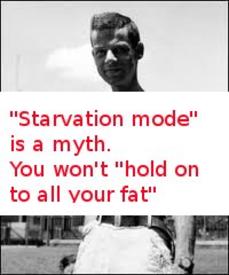Very interesting research on weight loss rate
Replies
-
That seems to be a common finding, there's usually some benefit to maintaining LBM of exercise, just like there is with high protein, but resistance training seems to do best.so you're saying that it is best to strength train more than do cardio in order to maintain lean body mass
Doing cardio and "eating back the calories" would appear to be of practically no value to weight loss.
One of those rare but not unheard of occaisions where we agree.0 -
That seems to be a common finding, there's usually some benefit to maintaining LBM of exercise, just like there is with high protein, but resistance training seems to do best.so you're saying that it is best to strength train more than do cardio in order to maintain lean body mass
Doing cardio and "eating back the calories" would appear to be of practically no value to weight loss.
Okay so let's say I strength train, burn 100 calories in the process with a resting TDEE of 1860 how much calories will I eat to rid the fat?
vs. if I do some cardio burn 300 calories I can allow myself to eat more calories to still create a decent deficit?
I am eager to make sense of this.0 -
Interesting, thanks for posting.
I had somehow dismissed resistance training as something "body builders do" and not considered the positive effects on metabolism and gaining/retaining muscle. So, I focused on cardio. A big mistake for me.
Since adding resistance in a few months ago progress has been out of sight on basically the same nutrition.
And this isn't some highly structured programme in a gym, just some bodyweight stuff.
I still like a decent long walk at a decent pace but I do that for the enjoyment more than some fat-blasting exercise to burn xxxx calories.
It's taken me 41 years to figure it out ... I'm a slow starter 0
0 -
That seems to be a common finding, there's usually some benefit to maintaining LBM of exercise, just like there is with high protein, but resistance training seems to do best.so you're saying that it is best to strength train more than do cardio in order to maintain lean body mass
Doing cardio and "eating back the calories" would appear to be of practically no value to weight loss.
Okay so let's say I strength train, burn 100 calories in the process with a resting TDEE of 1860 how much calories will I eat to rid the fat?
vs. if I do some cardio burn 300 calories I can allow myself to eat more calories to still create a decent deficit?
I am eager to make sense of this.
Well let's see if I can help a little. First there is no such thing as a resting TDEE. There is just a TDEE and that number will vary from day to day depending on activity. When you strenght train for an hour, you burn, say, 275 calories. But that is not the real benefit of stength training. The real benefit is EPOC or what is refered to as afterburn. For the next 18 to 24 hours you will burn calories at and increased rate. So the total burn is high. Usually in excess of cardio.
Also you work to make sure your lean muscle mass stays in tact and doesn't drop. Also not a benefit you get with cardio. Cardio will burn calories but not maintian muscle mass. So, it has the potential to cause you to go catabolic or lose critical lean muscle mass.
Most studies agree that strength training is the better way to lose primarily body fat and not lean muscle and body fat.0 -
Interesting, thanks for posting.
I had somehow dismissed resistance training as something "body builders do" and not considered the positive effects on metabolism and gaining/retaining muscle. So, I focused on cardio. A big mistake for me.
Since adding resistance in a few months ago progress has been out of sight on basically the same nutrition.
And this isn't some highly structured programme in a gym, just some bodyweight stuff.
I still like a decent long walk at a decent pace but I do that for the enjoyment more than some fat-blasting exercise to burn xxxx calories.
It's taken me 41 years to figure it out ... I'm a slow starter
And one of those rare times when you and I agree! Has the world turned upside down?0 -
That seems to be a common finding, there's usually some benefit to maintaining LBM of exercise, just like there is with high protein, but resistance training seems to do best.so you're saying that it is best to strength train more than do cardio in order to maintain lean body mass
Doing cardio and "eating back the calories" would appear to be of practically no value to weight loss.
Okay so let's say I strength train, burn 100 calories in the process with a resting TDEE of 1860 how much calories will I eat to rid the fat?
vs. if I do some cardio burn 300 calories I can allow myself to eat more calories to still create a decent deficit?
I am eager to make sense of this.
Well let's see if I can help a little. First there is no such thing as a resting TDEE. There is just a TDEE and that number will vary from day to day depending on activity. When you strenght train for an hour, you burn, say, 275 calories. But that is not the real benefit of stength training. The real benefit is EPOC or what is refered to as afterburn. For the next 18 to 24 hours you will burn calories at and increased rate. So the total burn is high. Usually in excess of cardio.
Also you work to make sure your lean muscle mass stays in tact and doesn't drop. Also not a benefit you get with cardio. Cardio will burn calories but not maintian muscle mass. So, it has the potential to cause you to go catabolic or lose critical lean muscle mass.
Most studies agree that strength training is the better way to lose primarily body fat and not lean muscle and body fat.
Okay. So i understand what you're saying general TDEE.Let's pretend I'm not as confused as I really am right now. I swear when I think I have it...I'm just scratching the surface. Here's what getting me....why does MFP set a deficit from your nonactive seated all day TDEE and when you add your exercise cals it appears on your dash board as you need to eat them back to avoid seeing the net calorie go below what is suppose to be your BMR?
So here's how I understand this, fill in the gaps...i.e.
person A TDEE prior to exercise, seating around =1860
person A tells MFP they want to lose 1.5lb per week
Well MFP will not allow you to go below 1200 calories (which I am assuming is your BMR and a set number for everyone?) so we replace person A's BMR which is 1298 (also what Person A should be netting at the end of the day). My understanding is that the reason for this betting your BMR is so that your body's basic functions needs are met. so 1298 is what Person A's body needs to perform basic functions.
1860-1298 = 562 deficit x 7 = person A can lose a little over 1lb a week. However this person will be eating 1298 cals to create that deficit...that's not a lot of food.
Now if you add in exercise Person As' TDEE will increase. Let's say they burn 300 with exercise +1830 = 2160
so now Person A's TDEE is 2160 - 562= 1598 (total person A can eat to create the same deficit).
so I easily see what you're saying that with Strength training you have a greater benefit of EPOC and less muscle loss, where as with cardio (unless HITT) you don't have the EPOC and you lose muscle. I also almost understand that your body can not distinguish exercise calories from a very busy day doing housework calories so then why the heck do we have the net??? Shouldn't it just be TDEE-BMR= Deficit? 2160-1298=862 assuming person A ate that low of cals....???
So then it would make sense to say not to eat below your BMR, rather than not to Net below your BMR because your body doesn't know the difference.
So person A is me...in this case I have studied my weight loss progress and have lost no weight creating higher deficits and netting less than my BMR..I attributed this to a couple factors, one which was mentioned in the initial article, exercising too much, mostly cardio minimal strength training and the other I thought was not eating enough...since i have been netting my BMR I have lost 3lbs...and I've still been working out more than 5 days a week until recently where i notice that if I don't take two days off I end up weighing more which I attributed to inflammation/lack of rest/water retention from elevated cortisol levels.
Okay I'm done. Sorry for the rant. thanks for explaining...hopefully this will help others.0 -
Okay so let's say I strength train, burn 100 calories in the process with a resting TDEE of 1860 how much calories will I eat to rid the fat?
vs. if I do some cardio burn 300 calories I can allow myself to eat more calories to still create a decent deficit?
Mathematically, in the short term...
Case A - Expenditure 1860 + 100 = 1960. Eat 1460. Deficit = 500
Case B - Expenditure 1860 + 300 = 2160. Eat 1760. Deficit = 500
Modify case B by eating between 1460 and 1760 and the deficit increases.0 -
It shouldn't be difficult to agree on things that are logical and supported by evidence.And one of those rare times when you and I agree! Has the world turned upside down?
Things like "netting your BMR" on the other hand, are a different story.0 -
It shouldn't be difficult to agree on things that are logical and supported by evidence.And one of those rare times when you and I agree! Has the world turned upside down?
Things like "netting your BMR" on the other hand, are a different story.
Hey I agree...I jumped on the Net your BMR or 1200 calories(which ever is higher) wagon when i joined MFP...I never heard of it before...and then of course with the body being so complex is actually seem to work a little for me...but that was a short term ride...0
This discussion has been closed.
Categories
- All Categories
- 1.4M Health, Wellness and Goals
- 394.9K Introduce Yourself
- 44K Getting Started
- 260.6K Health and Weight Loss
- 176.2K Food and Nutrition
- 47.5K Recipes
- 232.7K Fitness and Exercise
- 444 Sleep, Mindfulness and Overall Wellness
- 6.5K Goal: Maintaining Weight
- 8.6K Goal: Gaining Weight and Body Building
- 153.2K Motivation and Support
- 8.2K Challenges
- 1.3K Debate Club
- 96.4K Chit-Chat
- 2.5K Fun and Games
- 4.2K MyFitnessPal Information
- 16 News and Announcements
- 1.3K Feature Suggestions and Ideas
- 2.8K MyFitnessPal Tech Support Questions



